Pink mushrooms are an often overlooked and rarely discussed type of fungal life. Though they may seem strange, these unique species have been around for many centuries and can be found in a variety of ecosystems.
These mushrooms vary greatly in size, shape and coloration and each species has its own special characteristics that make it distinct from other fungi. Common pink fungi include pink oysters, pink brittlegill, and pink bonnets. Below we’ll discuss more about this unique fungus.
List of Pink Mushrooms
1. Pink Oysters
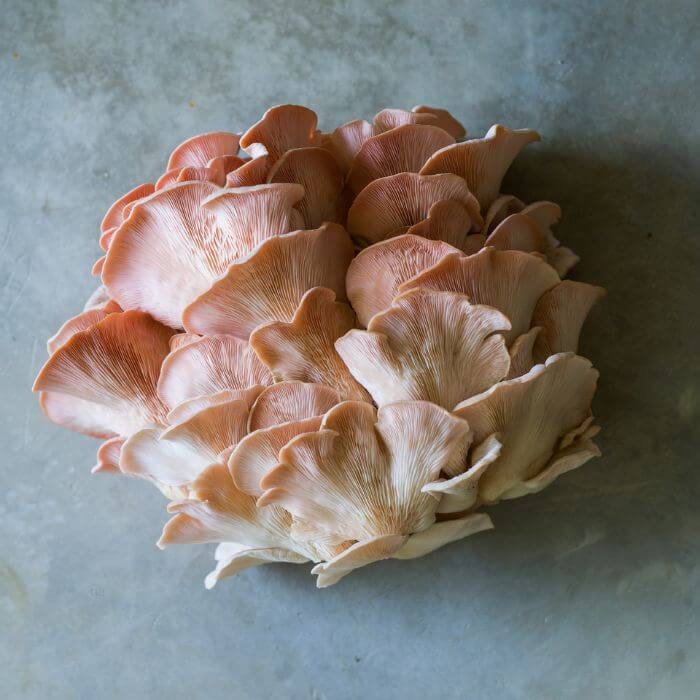
Pink oyster mushrooms are the most popular pink fungi in the world. Like other oysters, they are easy to cultivate.
Identification:
The most recognizable characteristics of the pink oyster mushroom are its cap shape and coloration. The cap is fan-shaped with a bright pinkish hue on the surface. The caps typically measure 1-3 inches across and grow on woody substrates such as logs, stumps, sawdust blocks, and fallen trees.
They are a popular choice for cultivation, as they have a delicious flavor and can be harvested in large amounts.
Pink Oyster Recipe
Roasted oysters
Ingredients:
– olive oil
– Soy sauce
-1 tablespoon chopped fresh thyme
-1 tablespoon chopped fresh rosemary
-1 teaspoon freshly ground black pepper
-8 ounces oyster mushrooms, thinly sliced
-1 lemon, juiced
-1 tablespoon chopped fresh parsley
Instructions: Preheat oven to 400 degrees F. Line a baking sheet with parchment paper. Cut the mushrooms in half and mix with the marinade. Place them on the prepared baking sheet and roast for about 20 minutes, or until they are tender and golden brown.
Mushroom Sauce
Ingredients:
-1/2 pound oyster mushrooms
-1/4 cup all-purpose flour
-1 teaspoon baking powder
-1/8 teaspoon black pepper
-3 tablespoons vegetable oil
-1/2 cup chicken broth
-1 tablespoon soy sauce
-1/4 teaspoon salt
Instructions:
1. Heat a skillet. Add the pink oysters and stir for 5 minutes
2. In a small bowl, whisk together the flour, baking powder, and pepper. Add to the skillet and cook, stirring constantly, until dark brown and bubbly.
3. Add soy sauce and broth and bring to a boil. Cook for 2 minutes to thicken. Season with sugar and salt, if desired. Serve hot
2. Pink Dome-cap Mushroom
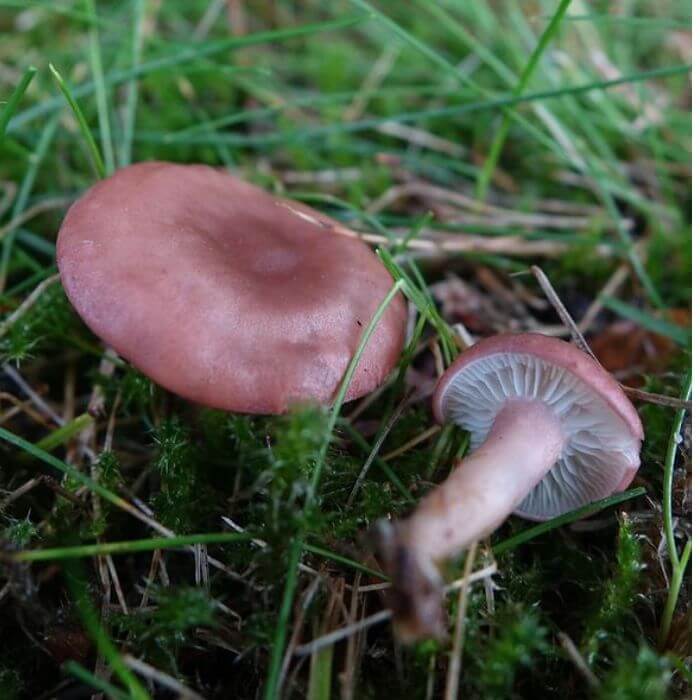
source: mushroomphotos
Pink dome-cap mushrooms, also known as pink fairheads, are often found in the United States and Europe.
Identification:
These are grassland mushrooms, often found hidden in tall grass. Young pink dome-caps have small convex caps that flatten with age. Caps range from 0.5-2.0 inches wide. Also note, older species will have wavy margins.
Their adnate and crowded creamish gills produce a similar colored spore print. The stem is also pinkish, smooth and with white flesh. This pink fungi is edible however because of their small size and chances of being confused with inedible species, we recommend you avoid them.
3. Rosy Brittlegill
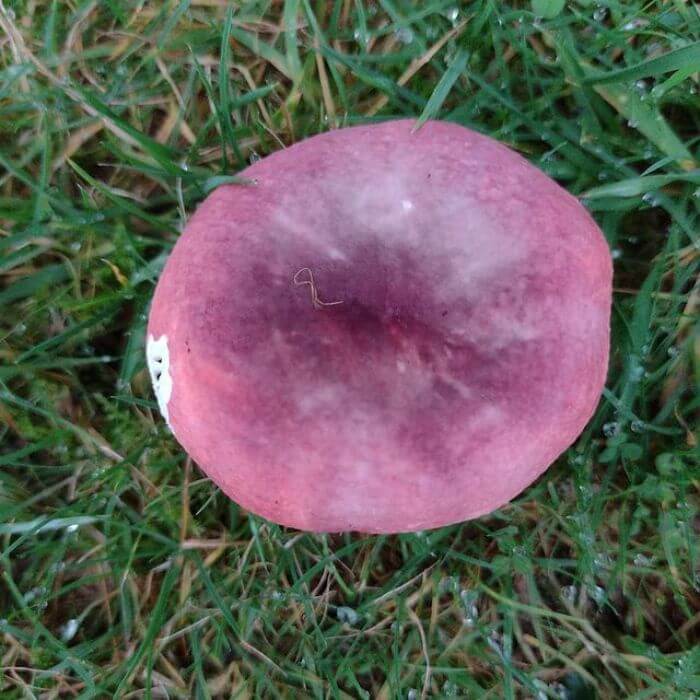
source: bobby_rickerby
Russula is one of the largest mushroom families. The rosy brittlegill is part of this large family and is common near beech trees.
Identification:
It’s characterized by its bright pink or reddish cap that grows to about 5 inches wide. Like other russulas, this pink mushroom starts out with a convex cap that flattens and develops a depression on the center.
Underneath, the forked white-creamish gills produce a pale spore print. These gills crumble easily when touched, giving these pink fungus its name. Pinkish stem is also brittle with a slightly swollen base.
What does rosy brittlegill taste like? Some foragers say it has a bitter taste, making it unpalatable.
4. Rosy Bonnets
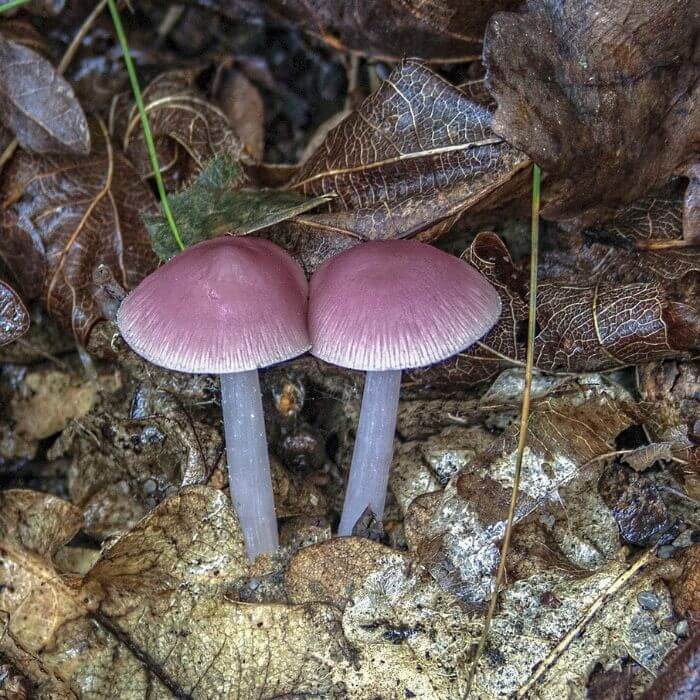
Rosy bonnets look great in photos but should not be harvested. They are inedible.
Identification:
This species of mushroom has a distinctive, bell-shaped cap that ranges in color from white to a gorgeous pink. It also has a hollow stalk that is usually the same color as the cap, but may be slightly lighter in hue.
The gills of this bonnet fungus are lilac-colored and well spaced. Its spore print is typically white. Additionally, pay attention to how tall the mushrooms grow; they usually reach heights between two and four inches tall when mature.
Where can you find rosy bonnets? They thrive beneath deciduous trees on decaying leaf litter.
5. Lepiota Brunneoincarnata
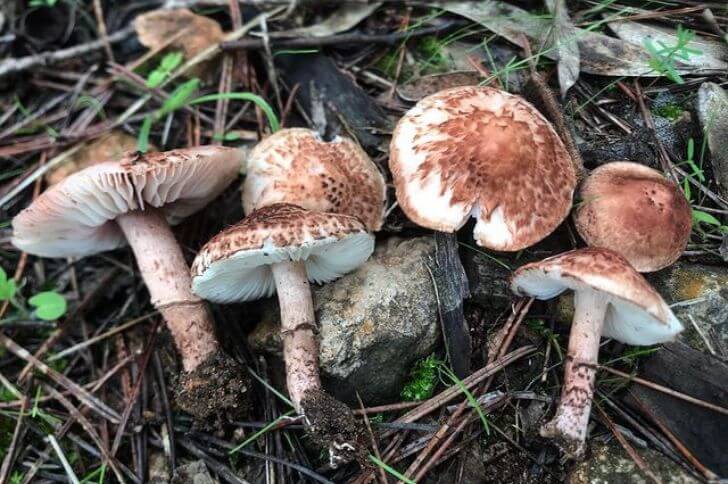
source: javier_ormad
The deadly dapperling, scientifically called lepiota brunneoincarnata, is a type of pink mushroom native to North America and parts of Europe.
Identification:
It is commonly found in grassy areas and woodlands during the spring and summer months. The deadly dapperling has an easily identifiable cap that ranges from reddish-brown to pinkish brown in maturity.
They grow to about two inches wide. Its gills are initially white but then turn a yellowish-brown color when mature. Stem is also pinkish.
Deadly dapperling should be avoided. They are classified as inedible.
6. Pink Waxcap
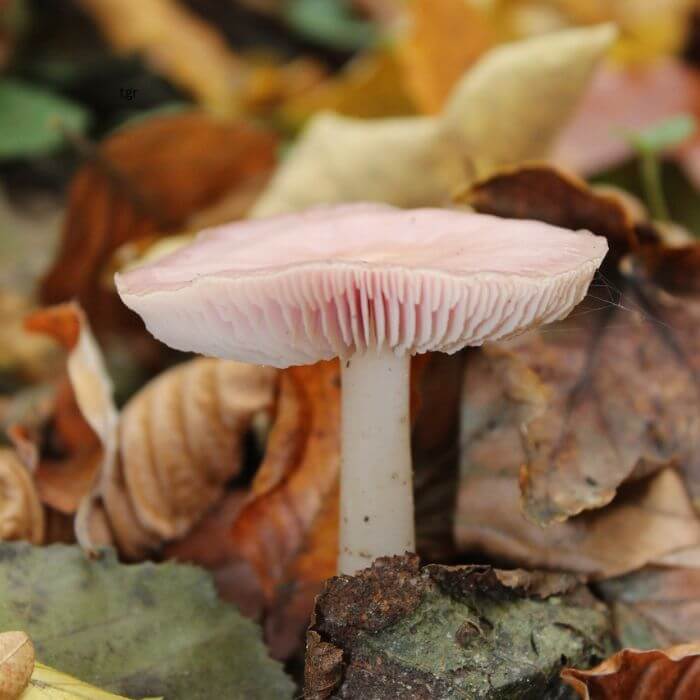
With its unique dome cap and gorgeous hue, the pink waxcap is another pink fungus that prefers virgin grasslands.
Identification:
With their vibrant pink color, it is easy to spot them against the green background. Pink waxcaps can be identified by their smooth, cone-shaped caps with pale pink coloring.
The gills of the mushroom are also a pink shade and well spaced. Its stem is white with white flesh and ranges from two to five inches long.
The IUCN has classified them as inedible and vulnerable. This waxcap is decreasing in numbers.
7. Ramaria Botrytis (Cauliflower Coral)
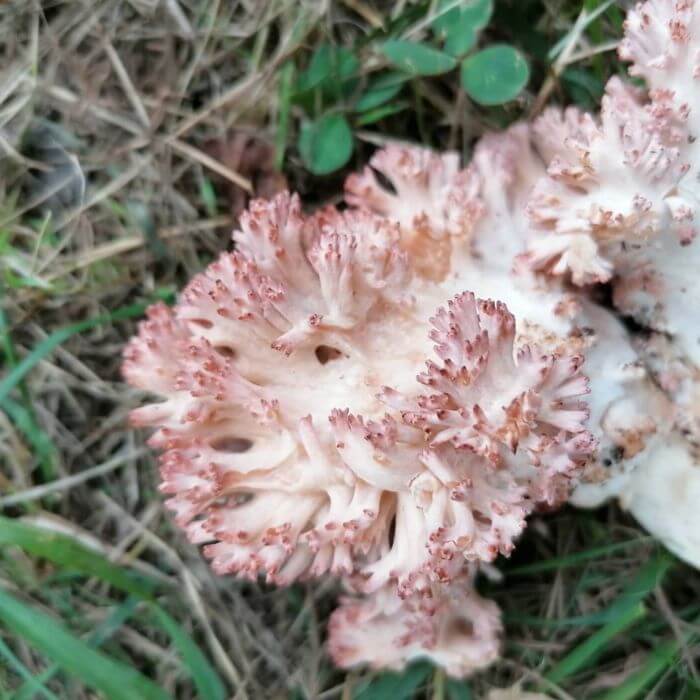
source: lilaheidelbeere
Ramaria botrytis, otherwise known as the cauliflower coral or clustered coral mushroom, is a type of edible pink that prefers beech woodlands.
Identification:
This mushroom is among one of the easier mushrooms to identify due to its distinct shape and color. Its common name ‘cluster coral’ comes from its branching structure which resembles an underwater coral reef system.
When these mushrooms grow together side by side they form clusters that can reach up to 6 inches wide or more! Look for them near deciduous trees such as oak, and conifers in moist forests during the fall months for best results.
Cooking this fungus is enjoyable. Because of their huge tight branches, they are easy to clean. You can add them to your noodle soup.
8. Boletellus Ananas
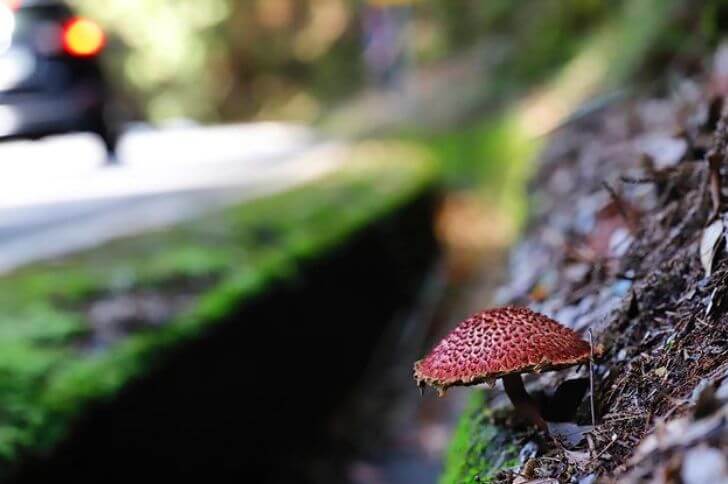
source: jamesho86
Boletellus Ananas, colloquially called pineapple bolete, is an intriguing and unique species of fungi.
Identification:
The color of pineapple bolete caps often vary from convex to flat. It is pinkish when young turning purple red at maturity. Also, unlike other boletes, the cap is not smooth. It has visible scales.
Underneath, this small bolete has a pore surface that is yellow and turns blue when bruised. The flesh too changes color when cut. Its spore print is also unique being a rust brown color. Alongside these features, this species has an unmistakable ‘musty’ odor.
9. Entoloma Austroroseum
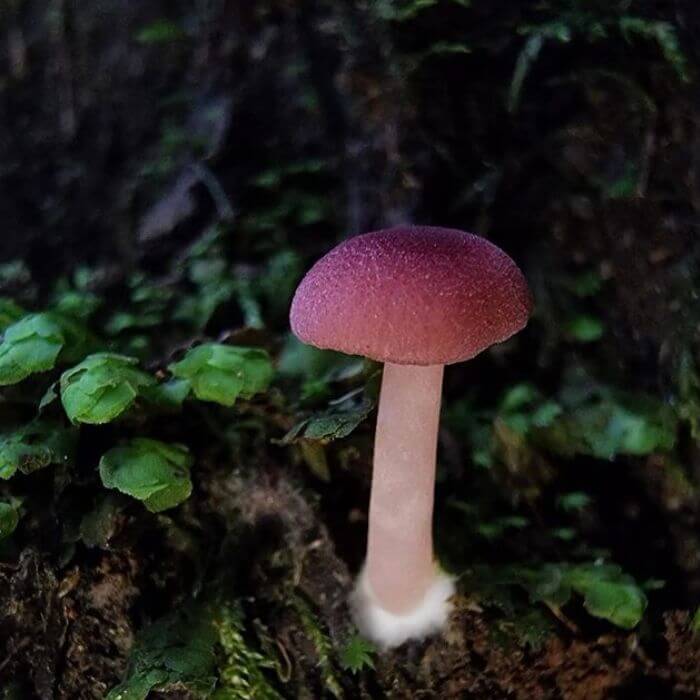
source: roryblack26
The entoloma austroroseum mushroom is one of the most beautiful and rare pink species of fungi in the world.
Identification:
Found primarily in Australia, this type of mushroom is known for its striking pink coloring. It has a convex cap with a dark pinkish-red center that fades into bright pink towards the edges. The gills are similarly colored .
FAQs
Are pink mushrooms real?
Yes! Pink mushrooms are indeed real and can be found in diverse habitats around the world. They can range in color from pastel pink to deep magenta, and they belong to several different species such as oyster.
Can you eat pink mushrooms raw?
No. Like all other types of mushrooms we advise you cook pink mushrooms thoroughly before consumption. Cooking helps to break down the cell walls of the mushroom and get rid of any harmful bacteria or toxins.
What kind of mushrooms are pink?
- Pink oysters
- Pink dome-cap mushrooms
- Rosy brittlegills
- Pink waxcap
- Rosy bonnets
Do you wash pink oyster mushrooms?
When selecting pink oyster mushrooms at the store or market, check for signs of dirt or debris on the outside and give them a quick rinse with cold water before using them in any dish. If you’ve cultivated your own pink oyster mushrooms from a kit, then you don’t need to worry about washing them beforehand as long as they have been kept in clean conditions and away from possible contaminants such as soil or animal droppings.
Should I refrigerate pink oyster mushrooms?
The answer is yes, you should definitely refrigerate all types of oyster mushrooms. This will help keep them fresh for longer periods of time and prevent spoilage. Keeping your pink oyster mushrooms in the fridge will also help maintain their texture and flavor.
They should be stored in an airtight container or plastic bag with a few holes punched in the top for ventilation. Additionally, make sure they are not overcrowded so that air can circulate freely around them.
Final Thoughts:
In conclusion,pink mushrooms are not just attractive and unusual, but surprisingly versatile. Some like the clustered coral and pink oysters are edible and can be cultivated from mushroom grow kits. As for other pink fungi species, just take a photo and do not harvest them.
Sources:
Hi There,
My name is Jenny. I’m the Chief Editor at Try Green Recipes and besides making yummy and healthy foods for my kids, grandkids, and friends. I’m new to the blogging world but I believe what I have to share is unique and will bring joy to your home. If you are adventurous and want try something tasty, let’s get started.

